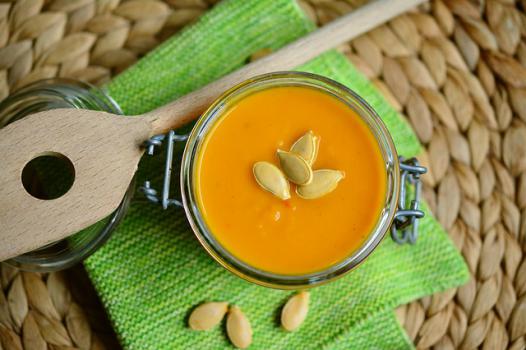First, let's take a look at the macros. Each of these are listed in grams and as usual, normalized to 200 calories for easy comparison, so we're always comparing apples to apples.
| Pumpkin | Chestnuts |
| Nutrient | pumpkin | chestnuts |
| Protein | 8g | 4g |
| Carbohydrate | 50g | 44g |
| Fiber | 4g | 0g |
| Fat | 1g | 1g |
| Monounsat. Fat | 0g | 1g |
| Polyunsat. Fat | 0g | 0g |
| Saturated Fat | 0g | 0g |

Next, let's take a look at the Vitamin density. These values are shown in units of percent of recommended daily intake. And since we're showing 200 calories worth, this means anything above 10% is good.
| Nutrient | pumpkin | chestnuts |
| Choline | 14% | 0% |
| Vitamin A | 454% | 1% |
| Vitamin C | 92% | 43% |
| Vitamin E | 68% | 0% |
| Vitamin K | 11% | 0% |
Pumpkin have significantly more Vitamins A, E, C, K than chestnuts. Pumpkin are a good source of Thiamin, Niacin, Magnesium, Zinc, Calcium. Pumpkin are a great source of Vitamin E, Vitamin C, Riboflavin, Pantothenic Acid, Vitamin B6, Potassium, Phosphorus. Pumpkin are an excellent source of Vitamin A, Iron. Chestnuts are a good source of Vitamin B6, Magnesium, Iron. Chestnuts are a great source of Vitamin C.

And here we see the B-vitamins: B1 (Thiamin), B2 (Riboflavin), B3 (Niacin), B5 (Pantothenic Acid), B6 (Pyridoxine)
| Nutrient | pumpkin | chestnuts |
| Vitamin B1 | 39% | 14% |
| Vitamin B2 | 77% | 15% |
| Vitamin B3 | 39% | 6% |
| Vitamin B5 | 46% | 10% |
| Vitamin B6 | 43% | 33% |
| Vitamin B12 | 0% | 0% |
Now, lets look at mineral density. Here we have a lot of important electrolytes and minerals. Once again, units are in percent of RDI, thus for this 200 calorie serving anything above 10% would considered high.
| Nutrient | pumpkin | chestnuts |
| Sodium | 1% | 0% |
| Potasium | 75% | 11% |
| Calcium | 32% | 3% |
| Magnesium | 26% | 21% |
| Phosphorus | 58% | 15% |
| Iron | 103% | 21% |
| Manganese | 42% | 62% |
| Selenium | 5% | 0% |
| Copper | 98% | 32% |
| Zinc | 26% | 8% |